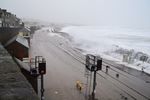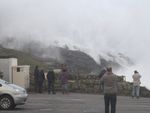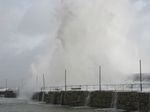The Wet and Wild Winter of 2013-2014 in west Cornwall
←
→
Page content transcription
If your browser does not render page correctly, please read the page content below
Penzance Weather Station Extreme Events Page - http://penzanceweather.atspace.com/wpage9.html
The Wet and Wild Winter of 2013-2014 in west Cornwall
DECEMBER 2013
It all started so benignly, then after a lovely sunny day with light winds on the 16th, the unsettled, very wet and sometimes stormy
conditions set in.
In December there were no really severe gales and Cornwall did not suffer the exceptional rainfall totals of areas farther east. It was
the sea conditions that were most memorable. At Sevenstones. just off Land’s End. the swell exceeded 20 feet on several days, peak-
ing around 29 feet during the morning of 27th. In Penzance 2013 ended with rain, hail, and a crash of thunder at 23:55, this heralded
in several weeks of stormy weather.
JANUARY 2014
The first significant event occurred on January 3rd. A large swell coincided with almost the highest Spring tide of the year and this
caused some major problems. There was flooding at St. Ives and Perranporth on the north coast, as well as Looe on the south. There
were also some intense squally showers with hail and thunder. In Penzance thunder occurred on three separate occasions during that
day, but this was just a forerunner of a quite exceptional event.
The Damaging Swell of 6th January 2014
On 6th January a very large and powerful swell arrived in Cornwall. It had been generated by a large, deep depression which had
been giving a prolonged period of westerly gales cross almost the full width of the Atlantic, particularly around 50 degrees northPenzance Weather Station Extreme Events Page - http://penzanceweather.atspace.com/wpage9.html There was extensive damage particularly, but not exclusively, along the north Cornwall coast. The swells seemed enormously dam- aging considering their size. The peak significant wave height at Sevenstones was 9 to 10 metres, this size of swell occurs typically once or twice a year. On March 10th 2008 the swell reached 12 metres! In Cornwall the wind was also not exceptional, the maxi- mum gusts were in the region of 65-70mph and around 50mph at my station in Penzance. So why, on this occasion, was so much damage done by the sea? An important factor was the fact that the waves were, having been formed well away in mid Atlantic, long period and fast moving. Such waves are subject to considerable focusing, resulting in some exceptional breaking waves at times and allowing them to affect areas normally fairly sheltered. The dominant wave period was 16-18 seconds. In deep water this gives a crest-to-crest wavelength of 400-500 metres, while in 20m water depth the crest-to-crest wavelength would be 200-250m. Such long waves with a significant height of 10m or so are immensely powerful. The speed of waves is governed by their wavelength. When a swell is first generated all sorts of wavelengths are generated at the same time. As the swells move away from the generation area the wavelengths sort themselves out, the faster, powerful waves in front. The first storm waves to arrive have the most punch to them and can do the most damage. In this event these powerful first waves arrived, certainly as far as Cornwall is concerned, around high tide. On January 6th I was at Sennen observing the conditions. As is normal the larger waves came in sets, but at around 09:50 there were two consecutive waves significantly larger than any oth- ers in the previous 30 minutes or so, causing a big reaction from the crowd of onlookers. These occasional ‘supersets’ are a not unu- sual feature and are down to constructive interference of 2 different wavelength swells, very well known to surfers. As the data buoys measure significant wave height averaged over a period of 20 minutes, these supersets, even if they hit the buoy, would only have a minimal affect on the significant wave height. However, it may well be that on this occasion they were responsible for some of the extreme damage. At Perranporth there was a 12-15 feet cliff in the sand cut out at the high tide mark. Towan beach, Newquay, was severely hit. The road to the Blue Reef Aquarium was badly damaged. The lookout on the end of Portreath pier (the Pepper Pot) was completely re- moved by just one wave. As well as man made features a number of natural coastal features were significantly changed by the storm. Further details of this storm can be found @ http://www.turnstone-cottage.co.uk/Jan06%202014%20Swell.pdf Then in Penzance, as a finale, there was a thunderstorm with several close flashes in the early hours of the 7th. The very unsettled conditions continued for the remainder of the month, but thankfully no repeat of January 6th. The month ended with very wet and windy conditions, the 31st being the wettest day of the month.
Penzance Weather Station Extreme Events Page - http://penzanceweather.atspace.com/wpage9.html
January broke a number of my records, which start in January 1991. It was easily the wettest, had the most days with rain and hail,
and the lowest average barometric pressure. During January the wind was predominantly from the SW, W or NW on 29 days, equal-
ling the record set in 1993.
The total rainfall was 256.4mm, 185% of the 1981-2010 norm and a new record.
Rain fell on 29 days (a new record for January)
Hail fell on 10 days (a new record for any month)
Thunder occurred on 3 days
FEBRUARY 2014
The first day of February saw another major storm, similar to the 6th January 2014 event
6th Jan 1st Feb
Tide Height (Newquay) 7.2m Tide Height (Newquay) 7.5m
Peak Significant Swell Height (Sevenstones) 30ft Peak Significant Swell Height (Sevenstones) 34ft
Wave Period (Sevenstones) 16-18 secs Wave Period (Sevenstones) 14 secs
Although the peak significant swell height and tide were higher this time, the slightly shorter period reduced the power of the swell,
so there wasn't quite the extreme erosional effect of the 6th January storm. However there was still significant flooding and consid-
erable further damage along the north coast. Bude, Perranporth, Newquay (especially Tolcarne and Towan) & St Ives were all badly
hit.
A fishing vessel sank off Newquay. Sea conditions were such that the crew had to jump into the sea in order to be winched up to a
helicopter. The vessel ended up on rocks near Porthcothan. So far the south coast of Cornwall had got off fairly lightly. This was all
set to change in a dramatic fashion.
The large Swell of 3rd February
On 3rd February another big swell, this time powering into the south coast of Cornwall on a strong SSE wind. The tides were still
very large (7.5m at Newquay) and with a 0.5m surge on top of that. There was flooding at places like Newlyn, Polperro, Porthleven
and especially Looe.
There was further damage to sea defences, including at Newlyn Green, where the sea washed a seal pup over the wall. Fortunately
the pup was not seriously hurt.
Big waves at Sennen near Land’s End - 1st February Damage at Newlyn Green - 4th FebruaryPenzance Weather Station Extreme Events Page - http://penzanceweather.atspace.com/wpage9.html
All of this was just a forerunner to
The great storm of 4th February
This one was exceptionally severe on the south Cornish coast, with a swell in Mount’s Bay comparable with the last two big storms
in the bay, Ash Wednesday 1962 and October 27th 2004. After a quiet start to the day, the wind rapidly increased in the afternoon.
By 16:00 it was gale to severe gale force SSE. Maximum gusts recorded in 87mph at John Chappell’s Land’s End site, 92mph on
St.Mary’s and 105mph on St. Martins (Scilly)!
There was extensive coastal damage around Mount’s Bay, caused by both the evening tide and the morning tide on the 5th, when the
wind was less strong, but the swell was bigger. The pier at Lamorna was largely destroyed and the sea washed cars from the car
park. In Mousehole the baulks were damaged, allowing the sea to surge into the harbour.
The broken Baulks - Mousehole A huge sea pounds the harbour wall at Mousehole
In Newlyn there was flooding, and the damage to the sea wall at Newlyn Green was significantly worsened. In Penzance there was
damage to the prom and to the Art Deco Jubilee Pool.
A start on repairs
at Newlyn GreenPenzance Weather Station Extreme Events Page - http://penzanceweather.atspace.com/wpage9.html In Porthleven the baulks were broken and many boats sank or were damaged. In Mullion there was more damage to the harbour walls. At many places, such as Perranuthnoe (just a couple of miles from Marazion) and Praa Sands, the repeated storms have denuded the beaches of sand, The following pictures show Perranuthnoe beach mid February and as it normally is from the same viewpoint. The sand will slowly return during the quieter weather, however, this is unlikely to be the case at Lamorna where the pier was effec- tively destroyed. It is the pier which collects the sand and forms a small harbour beach, no pier means no beach. The following few days the weather remained wild. There were further gales, westerly this time, on the 8th and 9th. Hail fell on 7 of the first 12 days of February. The 12th saw exceptional winds across Wales and northwest England, this time Cornwall escaped the worst, but then came. The damaging Valentines Day storm A depression moved up from Biscay, deepening as it did so. It brought heavy rain, severe southerly gales and, worst of all, another large sea. This increased the damage made to already weakened south coast sea defences. Ithere was considerable further damage to Penzance promenade and the Jubilee pool. The Pool in happier days This time the railway lines entering Penzance were damaged and flooded by the sea. The last time this occurred was in October 2004. The causeway from Marazion to St. Michael’s Mount was damaged and the small fishing village of Penberth near Land’s End saw further damage. It was this storm which did the most damage on Scilly, mainly due to the large waves overtopping the defences at the south facing Porthcressa beach.
Penzance Weather Station Extreme Events Page - http://penzanceweather.atspace.com/wpage9.html
The main line into Penzance on February 14th Repairs to Penzance promenade get under way
The weather remained unsettled and the month ended with another gale. On this occasion the strongest winds were from NNW and
only Scilly and the tip of Cornwall were affected. There were no particularly strong winds east of Truro, but head a little west and
St. Ives saw a gust of 83mph, Land’s End 75mph. I recorded 31.8mm of rain in the 24 hours to 09:00 on the 28th, the wettest day of
the year to date.
As was the case in January, February set a number of new records. At my station in Penzance the average wind speed @ 09:00 was
a record for any month. The number of gales, 6, equalled the February record (set in both 1996 & 1997) and there were more gales
in February than in any entire year since 2007. The number of rain days was a new record, and the 10 days with hail equalled the
record for any month, set in January 2014! The average pressure of 998mb was the 2nd lowest on record for any month, after 994 in
November 2000.
Winter (December – February) 2013-2014 - Overall Data
Temperature
Mean maximum:- 10.9C (+1.1)
Mean minimum:- 5.2C (+0.2)
Average temperature:- 8.1C (0.7C above the 1981-2010 average)
There was no air frost in Penzance all winter!
Rainfall
Total rainfall:- 625.0mm (163% of the 1981-2010 norm and the wettest on record)
There were 26 days with hail and 7 days with thunder, also new records
There was no snow
Wind
Number of gales 7 (1 in January, 6 in February)
The previous 5 winters only saw 4 gales in total - so an end to the run of benign winters.
Graham Easterling
Penzance
Penzance weather:- http://penzanceweather.atspace.com/weather.htmlYou can also read



























































